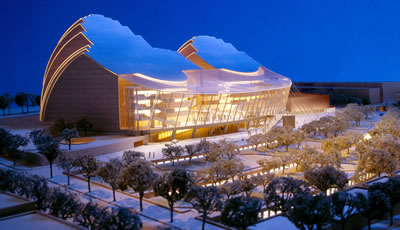 |  |  | |
 | The Kaufmann Center for the Performing Arts, scheduled to open in 2011, with be the subject of a special session and tours when USITT’s Annual Conference & Stage Expo visits Kansas City. The building is only part of recent investments in the arts. Photo/KCCVA | UMKC Mission: To Lead in the Performing Arts Kansas City is big on the arts. It’s downright bizarre that a metropolitan area of nearly two million people would see nearly $1 billion dollars spent in the first decade of the 21st Century in support of the arts. A number of new theatres have been built. Several of the major performing arts companies have built new administrative and production complexes. New galleries have opened. The Nelson-Atkins completed a $200+ million expansion and renovation. A designated arts district was even created, known as the Crossroads, centered a few blocks south of the downtown loop. When the Kauffman Center for the Performing Art opens in 2011, this new $400+ million home for three of Kansas City’s major performing arts groups becomes the capstone project of this developmental drive, with heightened hopes for the ballet, symphony, and opera, as well as civic impact upon the community. Created by the world’s leading designers in architecture, acoustics, and theatre engineering, the Kauffman Center will begin a new era of expectation as the crown jewel for the performing arts in Kansas City. How did Kansas City come to deserve such a fine facility? How did Kansas City, as reported by the Metropolitan Arts Council in 2007, actually sell more tickets to performing arts than professional sports? How do Kansas City’s performing arts groups collectively have a greater economic impact than professional sports? This arc of performing arts development and growth started 50 years ago, on what is now the campus of the University of Missouri-Kansas City (UMKC). At that time this site was the home of the University of Kansas City (UKC). In 1959 this private university, UKC, added the Kansas City Conservatory of Music as a new college. In 1963, UKC was absorbed by the University of Missouri System (UM) and became UMKC. In 1964, the Department of Theatre and Speech, under the chairmanship of Dr. Patricia McIlrath, launched the UMKC Summer Repertory Theatre, inaugurating the concept of a "Teaching Hospital for Theatre" in which theatre students could work side-by-side with theatre professionals. In 1971 the UM System launched its Role & Scope plan, designating certain campuses for the pursuit of excellence in specific disciplines. UMKC was designated as Missouri’s Campus for the Performing Arts, and until the early 2000's, the primary mission of UMKC was to "lead in the performing arts." Over these 50 years UMKC has focused on the performing arts and funded these programs accordingly. Exceptional faculties have been formed in the Conservatory of Music and Dance and within UMKC Theatre. While most UMKC students come from the greater KC area, the performing arts programs recruit talented students on a national basis and have attracted a consistent international pool. The university has supported the growth of the Summer Repertory Theatre as well, which has grown over the last 45 years into the LORT theatre known today as Kansas City Repertory Theatre, with a $7 million annual budget. As with any university, its greatest asset are its faculty and students. And the byproduct of UMKC’s commitment to the performing arts has been its greatest gift to this city: faculty and alumni are responsible for founding most of its major performing arts organizations. Conservatory faculty or alumni are directly responsible for the creation of the Kansas City Chorale, the Kansas City Ballet, the Lyric Opera of Kansas City, newEar Contemporary Chamber Ensemble, Quality Hill Playhouse, the KC Chamber Orchestra, Bach Aria Soloists, Wylliams/Henry Contemporary Dance Company, and many more. Faculty and alumni of UMKC Theatre have founded KC Repertory Theatre, the Coterie Theatre, the Unicorn Theatre, the New Theatre Restaurant, the American Heartland Theatre, Kansas City Actors Theatre, Martin City Melodrama, Gorilla Theatre, and many more. So the future of the performing arts looks bright for Kansas City, and it’s exciting to consider this wonderful synchronicity between 50 years of growth toward the Kauffman Center for the Performing Arts and 50 years of celebrating the wonder that is USITT, all coming together in a renovated downtown Kansas City looking forward to a wonderful new era. While visiting KC for USITT’s 50th Annual Conference, consider taking advantage of the following performing arts opportunities:
|